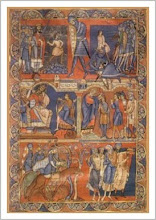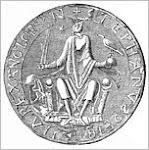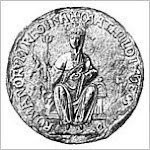• The Heptarchy - The Seven Kingdoms of Anglo-Saxon England
Northumbria: Northern Kingdom of the Angles and home to the Vikings
Northumbria first came into being at the beginning of the seventh century when the two kingdoms of Bernicia and Deira were unified by Aethelfrith, King of Bernicia, who conquered Deira around c.604AD. He in turn was defeated and killed in battle c.616AD by Raedwald of East Anglia. Raedwald granted the rulership to Edwin, the son of a former king of Deira, who accepted Christianity in 627AD. Edwin conquered the Isle of Man and Gwynedd in northern Wales. He was subsequently defeated at the Battle of Hatfield Chase in 633AD by an alliance of the exiled king of Gwynedd, Cadwallon ap Cadfan and Penda, king of Mercia.
Northumbria was divided once more. Eanfrith, a son of Aethelfrith, took power in Bernicia while a cousin of Edwin, Osric, became king in Deira. After the death of Eanfrith, his brother Oswald come to power and expanded his kingdom. In 642AD Oswald was killed by the Mercians at the Battle of Maserfield, then in 655AD Penda launched a massive invasion of Northumbria. He was aided by the sub king of Deira, Aethelwald, but suffered a crushing defeat and death by Oswiu at the Battle of Winwaed. Oswiu gained supremacy over Mercia and became the most powerful king in England. However, after a successful revolt by Penda's son Wulfhere Northumbria lost control of Mercia in c.658AD.
In 685AD Northumbria's king Ecgfrith, son of Oswiu, suffered a disastrous defeat at the hands of the Picts in the Battle of Nechtansmere. Ecgfrith was killed, and Northumbria's power in the north was weakened. The reign of Aldfrith, Ecgfrith's half brother and successor, was peaceful until his death in 704AD.
In 866/7AD Northumbria was conquered by Halfdan Ragnarsson and his brother Ivar the Boneless. Northumbria became the northern kingdom of the Danelaw. Viking rule brought lucrative trade to Northumbria and its capital York. Under the entry for the year 946AD, the Anglo-Saxon Chronicle records that king Edred of Wessex "reduced all the land of Northumbria to his control; and the Scots granted him oaths that they would do all that he wanted." Here the historical accounts of Northumbria become confusing, but it seems that the kingdom was finally absorbed by Edred after the death of the last independent Northumbrian monarch in 954AD. From this time the Earl of Northumbria was the title given to Northumbria's Ealdorman or ruler until it was eventually dissolved into the earldoms of York and Northumberland in the early Anglo-Norman period.
York:
York is a walled city, situated at the confluence of the Rivers Ouse and Foss, which was founded by the Romans in 71AD and called Eboracum. After the Roman departure it was taken over by the Angles and renamed Eoforwic, then in 866/7AD the Vikings captured it and they renamed it Jórvík. After the Norman conquest the name York slowly evolved, and was first used in the thirteenth century. During the Middle Ages York grew into a major wool trading centre and as the ecclesiastical capital of the northern portion of England.
• More about York:
• Explore the History of York
• Discover Durham Cathedral
Subscribe to:
Post Comments (Atom)








No comments:
Post a Comment